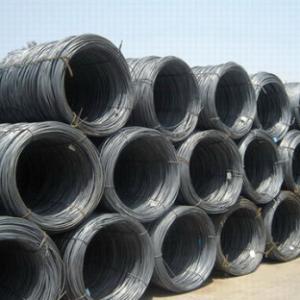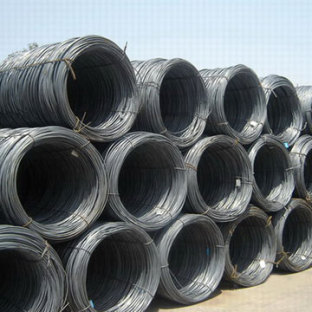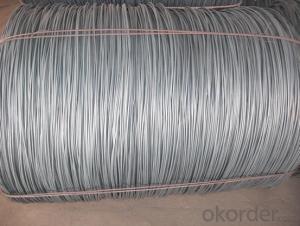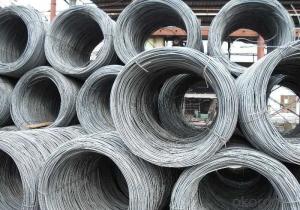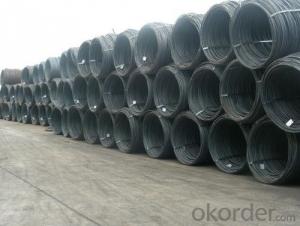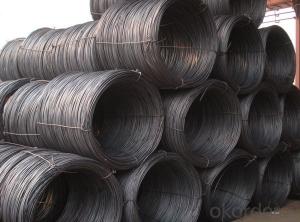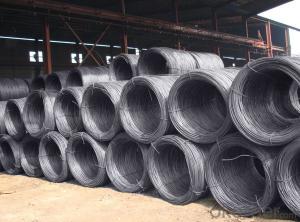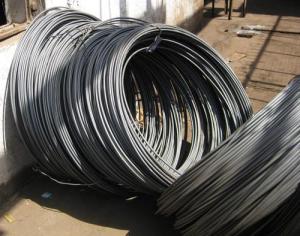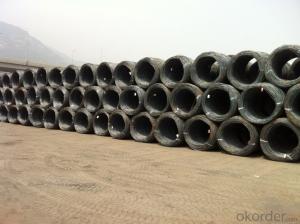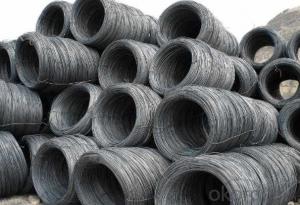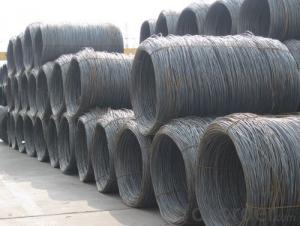Wire Rod 5.5MM-14MM SAE 1006 Or SAE1008 High Quality Hot Rolled
- Loading Port:
- China Main Port
- Payment Terms:
- TT or LC
- Min Order Qty:
- -
- Supply Capability:
- -
OKorder Service Pledge
OKorder Financial Service
You Might Also Like
Product Description:
OKorder is offering high quality Hot Rolled Steel I-Beams at great prices with worldwide shipping. Our supplier is a world-class manufacturer of steel, with our products utilized the world over. OKorder annually supplies products to European, North American and Asian markets. We provide quotations within 24 hours of receiving an inquiry and guarantee competitive prices.
Product Applications:
Deformed bar is widely used in buildings, bridges, roads and other engineering construction. Big to highways, railways, bridges, culverts, tunnels, public facilities such as flood control, dam, small to housing construction, beam, column, wall and the foundation of the plate, deformed bar is an integral structure material. With the development of world economy and the vigorous development of infrastructure construction, real estate, the demand for deformed bar will be larger and larger
Product Advantages:
OKorder's Steel I-Beams are durable, strong, and resist corrosion, exact size, regular package, chemical and mechanical properties are stable.
Main Product Features:
· Premium quality
· Prompt delivery & seaworthy packing (30 days after receiving deposit)
· Corrosion resistance
· Can be recycled and reused
· Mill test certification
· Professional Service
· Competitive pricing
Product Specifications:
Manufacture: Hot rolled
Grade: BS4449
Certificates: ISO, SGS, BV, CIQ
Diameter: 6mm,8mm,10mm,12mm,14mm,16mm,18mm,20mm,
22mm,25mm,28mm,32mm,36mm,40mm,50mm
Length: 6M, 9M,12M or as required
Packaging: Export packing, nude packing, bundled
Chemical Composition: (Please kindly find our chemistry of our material based on HRB500 as below for your information)
Grade | Technical data of the original chemical composition (%) | ||||||
C | Mn | Si | S | P | V | ||
HRB400 | ≤0.25 | ≤1.60 | ≤0.80 | ≤0.045 | ≤0.045 | 0.04-0.12 | |
Physical capability | |||||||
Yield Strength (N/cm²) | Tensile Strength (N/cm²) | Elongation (%) | |||||
≥400 | ≥570 | ≥14 | |||||
Theoretical weight and section area of each diameter as below for your information:
Diameter(mm) | Section area (mm²) | Mass(kg/m) | Weight of 12m bar(kg) |
6 | 28.27 | 0.222 | 2.664 |
8 | 50.27 | 0.395 | 4.74 |
10 | 78.54 | 0.617 | 7.404 |
12 | 113.1 | 0.888 | 10.656 |
14 | 153.9 | 1.21 | 14.52 |
16 | 201.1 | 1.58 | 18.96 |
18 | 254.5 | 2.00 | 24 |
20 | 314.2 | 2.47 | 29.64 |
22 | 380.1 | 2.98 | 35.76 |
25 | 490.9 | 3.85 | 46.2 |
28 | 615.8 | 4.83 | 57.96 |
32 | 804.2 | 6.31 | 75.72 |
36 | 1018 | 7.99 | 98.88 |
40 | 1257 | 9.87 | 118.44 |
50 | 1964 | 15.42 | 185.04 |
FAQ:
Q1: Why buy Materials & Equipment from OKorder.com?
A1: All products offered byOKorder.com are carefully selected from China's most reliable manufacturing enterprises. Through its ISO certifications, OKorder.com adheres to the highest standards and a commitment to supply chain safety and customer satisfaction.
Q2: What makes stainless steel stainless?
A2: Stainless steel must contain at least 10.5 % chromium. It is this element that reacts with the oxygen in the air to form a complex chrome-oxide surface layer that is invisible but strong enough to prevent further oxygen from "staining" (rusting) the surface. Higher levels of chromium and the addition of other alloying elements such as nickel and molybdenum enhance this surface layer and improve the corrosion resistance of the stainless material.
Q3: Can stainless steel rust?
A3: Stainless does not "rust" as you think of regular steel rusting with a red oxide on the surface that flakes off. If you see red rust it is probably due to some iron particles that have contaminated the surface of the stainless steel and it is these iron particles that are rusting. Look at the source of the rusting and see if you can remove it from the surface.
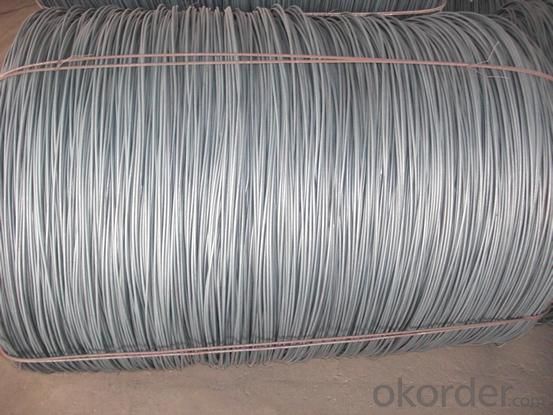
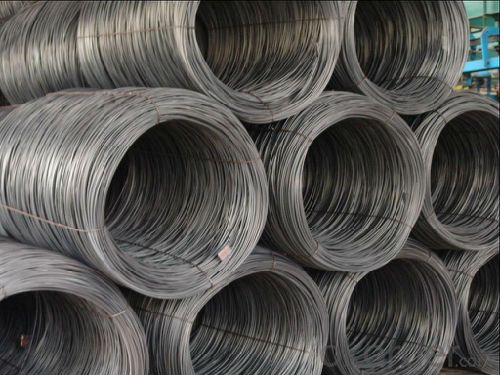
- Q: How is a steel wire rod manufactured?
- A steel wire rod is manufactured through a series of steps in a steel mill. The process begins with the melting of iron ore in a blast furnace to remove impurities and create molten iron. The molten iron is then transferred to a basic oxygen furnace (BOF) or an electric arc furnace (EAF) for further refining. In the BOF or EAF, the molten iron is combined with scrap steel and other alloying elements to achieve the desired composition and quality. This mixture is then subjected to high temperatures and chemical reactions, which help remove impurities and adjust the carbon content. Once the desired composition is achieved, the molten steel is cast into billets or blooms through continuous casting. These billets or blooms are solidified into a semi-finished product, which is then reheated to a rolling temperature. The reheated billet or bloom is then passed through a series of rolling mills. In the first stage, it goes through a roughing mill that reduces its size and shape. From there, it enters a series of intermediate and finishing mills, which gradually reduce the cross-sectional area and refine the shape further. During the rolling process, the steel is subjected to high pressure, which elongates it and reduces its diameter. This continuous elongation and reduction in size help improve the strength and ductility of the wire rod. After the final rolling pass, the wire rod is cooled and coiled onto a spool. It is then subjected to various surface treatments, such as pickling or coating, to remove any mill scale or oxidation and improve its surface quality. Finally, the wire rod is tested for its mechanical properties, dimensions, and surface quality. It is then either shipped to customers as a finished product or further processed into various steel wire products, such as wires for construction, automotive, or industrial applications. Overall, the manufacturing of a steel wire rod involves a combination of melting, refining, casting, rolling, and surface treatment processes to produce a high-quality product with the desired properties.
- Q: What are the different tensile strengths available for steel wire rod?
- The tensile strengths available for steel wire rod vary depending on the specific grade and composition of the steel. Common tensile strengths for steel wire rod range from 400 MPa (megapascals) to 1200 MPa, with some specialty grades reaching even higher strengths.
- Q: What are the different types of defects that can occur in steel wire rod?
- Steel wire rods can have various defects, which can arise from manufacturing or external factors. Examples of defects include surface, internal, and dimensional defects. Surface defects, such as scratches, pits, cracks, and scale, are easily visible and can occur due to mishandling, improper storage, or issues during rolling or finishing processes. These defects can affect the appearance and functionality of the wire rods, often requiring additional processing or treatment for correction. Internal defects, which are not visible from the surface, can weaken the wire rod and reduce its mechanical properties. Inclusions are foreign particles trapped within the steel matrix during manufacturing, voids are areas lacking material, and segregations refer to variations in composition or structure. These defects make the wire rod more susceptible to failure under stress or load. Dimensional defects refer to variations or deviations from specified dimensions and tolerances. These defects can include differences in diameter, out-of-roundness, straightness, or surface finish. Issues with the rolling process, cooling or heat treatment, or variations in raw materials can cause these defects. They can affect the suitability and performance of the wire rod for its intended use. To minimize defects, it is crucial to follow proper manufacturing practices, implement quality control measures, and adhere to industry standards and specifications. Regular inspection and testing of wire rods can help detect and rectify any defects, ensuring the production of high-quality and dependable steel wire rods.
- Q: How is steel wire rod used in the manufacturing of wire rope assemblies for construction purposes?
- Steel wire rod is an essential component in the manufacturing of wire rope assemblies for construction purposes. Wire rope assemblies are widely used in construction for various applications such as lifting heavy loads, securing structures, and providing structural support. Steel wire rod serves as the raw material for producing the inner strands and outer strands of a wire rope assembly. These strands are made by twisting multiple individual wires together, forming a strong and durable rope. The wire rod used in this process is typically made from high-quality carbon steel, which provides the necessary strength and resilience required for construction applications. The manufacturing process begins with the steel wire rod being cleaned and coated with a lubricant to reduce friction during the twisting process. The wire rod is then drawn through a series of dies to reduce its diameter and increase its length. This drawing process helps to align the steel's grain structure, enhancing its strength and flexibility. Once the wire rod has been drawn, it is fed into a stranding machine where multiple wires are twisted together to form individual strands. These strands are then combined in a specific pattern to create the wire rope assembly, with the inner strands providing strength and the outer strands providing protection. The wire rope assembly is then subjected to various quality control measures to ensure it meets the required specifications for construction purposes. These measures may include testing for strength, flexibility, and resistance to corrosion. Once approved, the wire rope assembly is ready to be used in construction projects. In construction, wire rope assemblies made from steel wire rod are used for a wide range of applications. They are commonly used in cranes and hoists to lift heavy loads, providing a safe and reliable lifting solution. Wire rope assemblies are also utilized in the construction of suspension bridges, where they provide support and stability. Additionally, wire rope assemblies are used for securing structures, such as in the installation of safety barriers or anchoring systems. Overall, steel wire rod plays a crucial role in the manufacturing of wire rope assemblies for construction purposes. Its strength, durability, and versatility make it an ideal material for use in various construction applications, ensuring the safety and reliability of structures and equipment.
- Q: How is the diameter of steel wire rod measured?
- To determine the diameter of a steel wire rod, one commonly employs a micrometer, a specialized precision measuring instrument. This device is specifically crafted to achieve precise measurements of small distances or thicknesses. Comprising a calibrated screw mechanism paired with a spindle, the micrometer is meticulously manipulated until it delicately makes contact with the wire rod's surface. The resulting measurement is subsequently read from the micrometer's scale, which frequently incorporates both metric and imperial units. By employing this technique, one guarantees precise and uniform determination of steel wire rod diameters.
- Q: How are steel wire rods used in the production of wire springs for mechanical devices?
- Steel wire rods are an essential component in the production of wire springs for mechanical devices. These wire rods are made of high-quality steel that possesses excellent strength and elasticity properties. To begin, the steel wire rods are first processed through a series of manufacturing steps. This includes cleaning the rods to remove any impurities and then heating them to a specific temperature to make them more malleable. Once heated, the rods are passed through a series of rollers, which gradually reduce their diameter to the desired size. This process, known as wire drawing, ensures that the steel wire rods are of the correct thickness for the production of wire springs. After the wire drawing process, the steel wire rods are further treated to enhance their properties. This may involve heat treatment processes such as annealing or quenching, which can increase the strength and elasticity of the wire. Additionally, the rods may also undergo surface treatments such as electroplating or coating to improve their corrosion resistance. Once the steel wire rods are prepared, they are then used to manufacture wire springs for mechanical devices. Wire springs are widely used in various applications, ranging from automotive suspension systems to household appliances. The wire rods are fed into specialized machinery, where they are coiled or bent to form the desired shape of the spring. The machinery applies tension and pressure to the wire rods, causing them to deform and take on the spring shape. The quality and properties of the steel wire rods play a crucial role in determining the performance and durability of the resulting wire spring. In summary, steel wire rods are essential raw materials in the production of wire springs for mechanical devices. They undergo various manufacturing processes to ensure the desired strength, elasticity, and corrosion resistance. Once prepared, the wire rods are used in specialized machinery to form wire springs, which are critical components in a wide range of mechanical devices.
- Q: What are the main factors influencing the choice of steel wire rod after-sales service?
- The choice of steel wire rod after-sales service is influenced by several main factors. Firstly, the quality of the service provided plays a crucial role. Customers expect prompt and effective after-sales support, including timely response to inquiries, technical assistance, and problem resolution. A reliable after-sales service ensures customer satisfaction and builds trust in the supplier. Secondly, the availability and accessibility of spare parts and components are important considerations. If a customer encounters any issues with the steel wire rod, they would expect the supplier to have a readily available stock of spare parts to quickly address the problem. This minimizes downtime and ensures uninterrupted production. Additionally, the expertise and knowledge of the after-sales service team are critical factors. Customers value suppliers that have well-trained and experienced service technicians who can provide expert advice and guidance. This helps customers optimize the performance of the steel wire rod and address any operational challenges they may face. Another influential factor is the cost-effectiveness of the after-sales service. Customers look for service packages that offer value for money, including reasonable prices for spare parts, maintenance contracts, and repair services. A cost-effective after-sales service ensures that customers receive the necessary support without incurring significant additional expenses. Furthermore, the geographical coverage and response time of the after-sales service team are considered. Customers prefer suppliers with a wide service network, enabling them to receive support even in remote locations. Additionally, a fast response time is crucial to minimize production downtime and maintain efficient operations. Lastly, customer feedback and reputation also influence the choice of steel wire rod after-sales service. Positive testimonials and references from existing customers can instill confidence in potential buyers. Therefore, suppliers who consistently receive positive feedback and have a strong reputation for excellent after-sales service are more likely to be preferred. In conclusion, the main factors influencing the choice of steel wire rod after-sales service include the quality of service, availability of spare parts, expertise of the service team, cost-effectiveness, geographical coverage, and reputation. By considering these factors, customers can make an informed decision and choose a supplier that meets their after-sales service expectations.
- Q: What are the different types of steel wire rod drawing machines?
- There are several different types of steel wire rod drawing machines used in the manufacturing industry. Some of the most commonly used machines include: 1. Single Block Drawing Machine: This is the simplest type of wire rod drawing machine. It consists of a single block through which the wire rod is passed multiple times to reduce its diameter. This machine is ideal for drawing thin wires with high precision. 2. Double Block Drawing Machine: As the name suggests, this machine consists of two blocks through which the wire rod is passed. The wire rod is first passed through the first block to reduce its diameter, and then it is passed through the second block to further reduce the diameter. This machine is commonly used for drawing medium-sized wires. 3. Multi Block Drawing Machine: This type of machine consists of multiple blocks through which the wire rod is passed in a sequential manner. Each block reduces the diameter of the wire rod, resulting in a more precise and uniform wire. Multi block drawing machines are often used for drawing thicker wires. 4. Bull Block Drawing Machine: This machine is specifically designed for drawing large diameter wire rods. It uses a rotating bull block with grooves to reduce the diameter of the wire. The wire rod is pulled through the rotating block, which applies pressure and friction to the wire to reduce its diameter. 5. Continuous Drawing Machine: This is a highly automated machine that continuously draws the wire rod to reduce its diameter. The wire rod is fed into the machine, and it passes through a series of blocks or dies that progressively reduce its diameter. Continuous drawing machines are commonly used for mass production of wires. These are just a few examples of the different types of steel wire rod drawing machines available in the industry. The choice of machine depends on the specific requirements of the wire being produced, such as diameter, precision, and production volume.
- Q: How is steel wire rod used in the manufacturing of electrical conductors?
- Steel wire rod is used in the manufacturing of electrical conductors as it provides the necessary strength and flexibility required to transmit electricity efficiently. The wire rod is drawn into thin wires which are then insulated and used as the core of electrical cables. These conductors are widely used in power transmission lines, electrical wiring systems, and various electrical appliances to ensure the safe and reliable flow of electricity.
- Q: What are the factors that determine the price of steel wire rod?
- There are several factors that determine the price of steel wire rod. Some of the key factors include the cost of raw materials such as iron ore and other alloys, the demand and supply dynamics in the market, production and transportation costs, energy prices, currency exchange rates, and any taxes or tariffs imposed on steel imports or exports. Additionally, factors like global economic conditions, trade policies, and technological advancements in the steel industry can also influence the price of steel wire rod.
Send your message to us
Wire Rod 5.5MM-14MM SAE 1006 Or SAE1008 High Quality Hot Rolled
- Loading Port:
- China Main Port
- Payment Terms:
- TT or LC
- Min Order Qty:
- -
- Supply Capability:
- -
OKorder Service Pledge
OKorder Financial Service
Similar products
Hot products
Hot Searches
Related keywords
